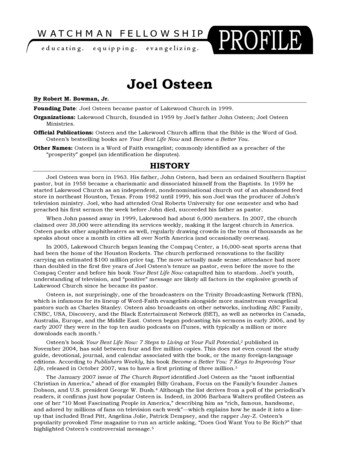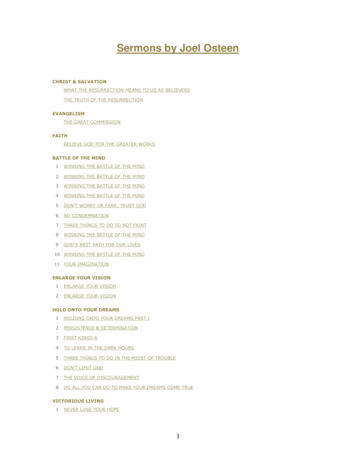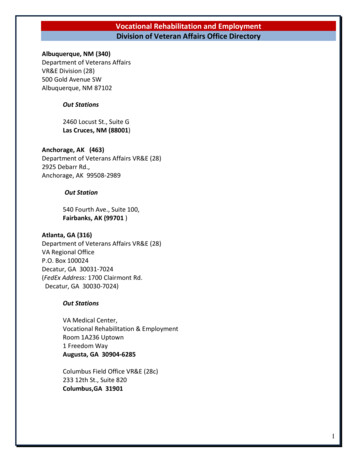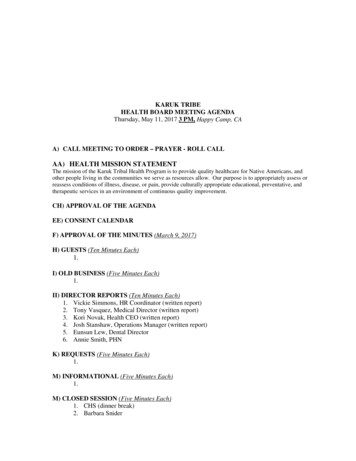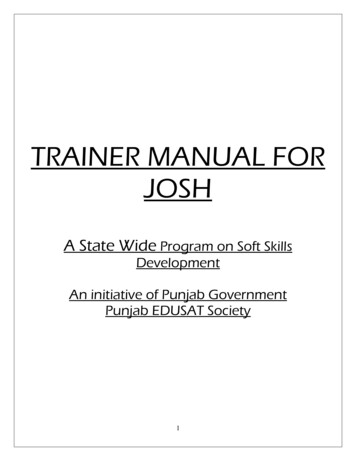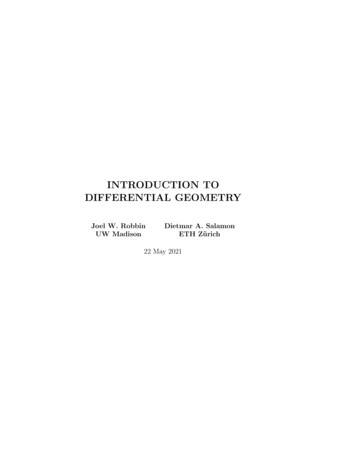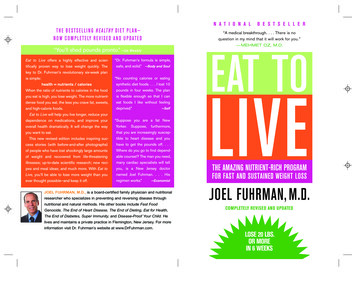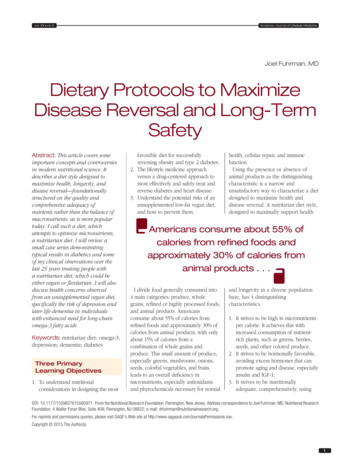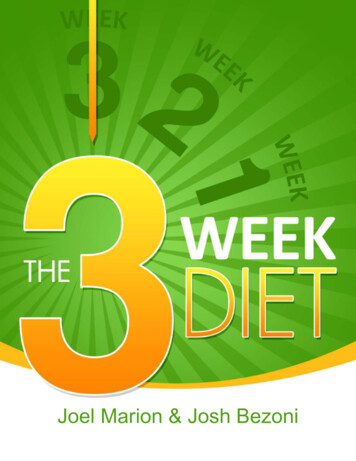
Transcription
Joel Marion & Josh Bezoni
The 3-Week DietJoel Marion, CISSN, NSCA-CPTWith Nutritionist Josh Bezoni2
Legal DisclaimerThe information presented in this work is by no way intended as medicaladvice or as a substitute for medical counseling. The information should beused in conjunction with the guidance and care of your physician. Consult yourphysician before beginning this program as you would with any exercise andnutrition program. If you choose not to obtain the consent of your physicianand/or work with your physician throughout the duration of your time using therecommendations in the program, you are agreeing to accept full responsibilityfor your actions.By continuing with the program you recognize that despite all precautions on thepart of BioTRUST Nutrition , LLC, there are risks of injury or illness which canoccur because of your use of the aforementioned information and you expresslyassume such risks and waive, relinquish and release any claim which you mayhave against BioTRUST Nutrition, LLC, or its affiliates as a result of any futurephysical injury or illness incurred in connection with, or as a result of, the use ormisuse of the program.3
Easy Document NavigationQuick Introduction5Nutrient Confusion —Your Key to Accelerating Your Results and DeterringWeight Loss Plateaus5Determining Portion Sizes8A Note On. Counting CaloriesMeal FrequencyA Note On. Food Prep101214The 5 Types of Days15The 3 Week Diet Outline16The Cheat Day17The Fast Day18A Note On. Water Intake21The Shake Day22The Low Carb Day26A Note On. Sleep27The Moderate Carb Day29A Note On. Exercise31Acceptable Carbohydrate Sources32Acceptable Protein Sources33Acceptable Fat Sources33Free Veggies34Tracking Progress34A Note On. Goals383 Week Diet Supplementation Plan40Foundational Supplements40Highly Recommended Progress-Accelerating Supplements46Other Recommended Convenient Nutrition Products48FAQs494
Quick IntroductionAlright, here we are—this is the no-fluff, “exactly what to do,” how-to guide forthe 3 Week Diet. Within this manual, we will briefly cover the science behind thestrategic setup of the 3 Week Diet; however, this will serve primarily as a user’sguide without all the filler.After all, you probably don’t want to read a novel. you just want to know what todo. And that’s what we’re here to show you.With that said, if you do have any additional questions about the science behindthe diet’s setup—or any questions whatsoever for that matter—we invite you tojoin our Private VIP Facebook Community. There, you can get FREE healthand fitness coaching and support from our inspiring community of folks just likeyou. Stop by and introduce yourself today! Click here to visit our Private VIP Facebook GroupTo get started, we need to take a moment to discuss the diet’s most fundamentalprinciple: Nutrient Confusion .Nutrient Confusion —Your Key toAccelerating Your Results and DeterringWeight Loss PlateausThe foundational principle of the 3 Week Diet, and the entire reason this strategicapproach works so well, is something we call Nutrient Confusion .With Nutrient Confusion , we confuse the body by giving it varying amounts ofmacronutrients and calories on a daily basis in an effort to avoid the negativemetabolic adaptations of dieting, not to mention the dreaded “starvation mode”when the body shuts down its metabolism and outright refuses to burn fat.You see, when you go on a diet your body isn’t aware of—nor does it careabout—your fat loss goals and hopes for a slim waistline. The only thing it does5
know is that, when you start dieting, you “all of the sudden” begin taking indrastically lower amounts of calories than you were previously. And, to your body,that’s a big red flag.When this happens, your body essentially initiates a “protective” starvationresponse—slowing your metabolism and putting the brakes on fat burning.The major hormone responsible for this response is leptin, which is an “antistarvation” and “energy-sensing” hormone that plays a critical role in energybalance. When calorie and food intake is within an optimum zone, circulatingleptin levels remain normal, and the body is primed to burn fat as fuel.When you go on a diet, however, leptin levels quickly drop, letting the brain knowthat something is “wrong,” and as a result, the body responds with a cascadeof energy preservation mechanisms to prevent what it perceives as potentialstarvation.For instance, some of the adaptations include: Reduced metabolic rateDecreased thyroid hormone outputIncreased appetite and activity of hunger centersIncreased activity of food reward centersReduced sympathetic nervous system activityIncreased parasympathetic nervous system activityDecreased reproductive hormone outputReduced spontaneous physical activityIncreased muscular efficiencies (i.e., burning fewer calories per movement)This all adds up to reduced calorie burn and increased hunger and appetite (i.e.,drive to eat more) all in an effort to help match energy expenditure with energyintake. A little something that scientists call “homeostasis,” and this is bad newsfor the dieter, as the reality is quite simple: Our bodies make it very difficult tolose weight through calorie restriction, although creating an energy deficit isnecessary in order to lose weight. [Let’s make that perfectly clear: To lose fat,you need to eat fewer calories than you burn.]6
Enter Nutrient Confusion .The key here is to create a calorie deficit (so you can burn and lose fat) while atthe same time preventing your body from entering “starvation mode.”By altering our daily calorie and macronutrient (e.g., carbohydrate) intake, we caneffectively “confuse,” or “trick,” the body.You see, research has shown that it only takes about a week for leptin levelsto plummet by as much as 50%, putting you at just HALF of your fat-burningpotential. Research also shows that manipulating calorie intake, particularlyby adjusting carbohydrate intake, can give leptin levels a nice boost—evenpreventing it from falling off too rapidly in the first place.As mentioned, the key nutrient here is carbohydrates, as research has shownthat a boost in the carbohydrate-regulating hormone insulin also yields a boostin leptin levels. So, by manipulating carbohydrate intake every so often to boostleptin levels and prevent your body from “catching on” that you’re dieting, you’llbe able to create a sizable calorie deficit (and burn lots of fat) while avoidingstarvation mode and keeping your body in fat-burning mode around the clock. It’sa nifty trick, and it works very well.Even better, we’ve put together a very strategic carbohydrate manipulation planfor you over the course of 21 short, but very effective days, and if you’re readingthis manual, you’ll get access to that breakthrough schedule in just a moment.In addition to the carbohydrate manipulation techniques used in the 3 WeekDiet, we also use many other cutting-edge, metabolism-boosting, fat-burningtechniques—including strategic Cheat Days and Intermittent Fasting—to makethe diet even more effective.Without further ado, let’s jump into all the info you need to know to execute thefat-burning 3 Week Diet!7
Determining Portion SizesAs you’ll see throughout the manual, consistency with food quality (i.e., foodchoices) and quantity (i.e., portion sizes) along with appropriate macronutrientratios (for your needs, goals, and activity levels) are the most important factors inachieving your body transformation goals.Within the set up of the program, we recommend using portion sizes as a helpfulstart to determine “how much” food to eat at each meal.Let’s talk about how to determine the appropriate portion size for you and yourbody for each of the three macronutrients: Protein, carbohydrates, and fat.To do this, you won’t need any measuring cups, food scales, or cumbersomecalorie-counting software; all you’ll need is your hand.Here’s how it works: Your palm determines your protein portionsYour fist determines your vegetable portionsYour cupped hand determines your carb portionsYour thumb determines your fat portionsLet’s take a look at this in action.For protein-rich foods (pg. 33) like meat,chicken, fish, and eggs, use a palm-sizedserving.Note: You’ll be consuming a portion of proteinat each feeding. Generally speaking, a palmsized portion provides about 20 – 30 gramsof protein. Men and more active folks mayneed to consume two palm-sized portions perfeeding.8
For vegetables (pg. 35), like greens, cauliflower,broccoli, carrots, etc., use a fist-sized serving:Note: We recommend consuming 1 – 2 fist-sizedservings of vegetables at each feeding.For carbohydrate-dense foods (pg. 32), likefruits, potatoes, beans, rice, and the like, use acupped hand to determine your portion size:Note: As part of the Nutrient Confusion principle, you’ll only be consuming carbohydratedense foods on certain days (e.g., Shake andModerate Carb Days). On those days, moreactive individuals may need to eat more (e.g.,two cupped handfuls) while sedentary folks mayneed to consume less.For healthy fats (pg. 34), like oils, butter, nuts,and nut butters, use your thumb as a guidelinefor an appropriate serving size:Note: Some find that using the “tip” (or firstknuckle) of the thumb for pure fats (e.g., oils) is agood rule of thumb (no pun intended). For otherfoods (e.g., nuts, nut butters, cheese), using afull thumb (or two) is a good starting point formost. You’ll be eating fat-dense foods at themajority of your meals.Full lists of recommended foods that fall into these respective categories areprovided later on in the manual.Besides being able to take them with you anywhere, the reason why hand-basedportion sizes work so well is that they are relative to the size of the individual.Smaller people with smaller hands will eat less food because they require fewer9
calories. Similarly, larger people with correspondingly bigger hands will eat morefood because they require more calories.It’s simple, and it’s a great starting point. But remember, it’s just that, a startingpoint, and you may need to adjust your intake slightly based on your activitylevels (e.g., more active folks need to eat more), hunger, fullness, and progress.A good nutrition plan raises awareness and attention. Eat slowly and mindfullyand pay attention to your body’s cues of fullness and hunger. A good nutritionplan also incorporates outcome-based decision making. In other words, take timeevery so often to ask yourself, “How’s this working for me?” If you’re strugglingwith your progress, maybe it’s time to honestly assess your portion sizes or cutback on a cupped handful of carbohydrates.A Note On Counting CaloriesYou may be asking yourself, “Where are the numbers?” Or “How many calories,carbohydrates, etc., am I supposed to eat each day?” These are fantasticquestions, and if you’re anything like most folks who’ve dieted before, you mayhave experienced the anxiety and restriction of calorie counting. Before delvinginto the question a bit further, one question that you might ask yourself (aboutthose previous experiences) is: “How did that work for you?”For most people, the “numbers game” (i.e., counting calories) does not work forproducing lasting change and supporting long-term weight management. Simplyput, balancing and counting calories is not intuitive; it’s not the way that humansare intended to interact with food. Rather, the way that we intuitively interactwith food is to eat when we’re truly hungry and stop when we’re not. Certainly,that’s easier said than done, but when the emphasis is placed consistentlyon food quality combined with a healthy food environment, intuitive eatingbecomes habit.With that being said, keeping a food journal, which may include countingcalories, can be an incredibly valuable tool, especially in the short-term. In fact,we recommend that you keep a food journal, and it may even be a good idea to10
keep a photo food journal. Food journals, food tracking applications, andcounting calories help create awareness, and raising awareness and attention(to food quality and quantity) is a key aspect of any good nutrition plan.In other words, if you do prefer to count calories, try to use it as an activeawareness tool instead of letting it rule or control you. Overall, in our experiencewith thousands of folks, we’ve found that there are a few different problems withplaying the numbers game:- Numbers are fairly meaningless to most people (i.e., people eat FOOD, notcalories).- Numbers don’t tell us much about food quality.- Numbers don’t consider food environment and its impact on eating behaviors.- Numbers are often wrong (e.g., calorie estimates can be off by as much as20%).- Numbers don’t translate into how foods and nutrients act in the body.- Numbers don’t tell us much about an individual’s internal environment (e.g.,why or how someone is eating or not eating; why or how someone is makingthe choices they are).- Numbers create an external “locus of control.” Calorie counting takes awayfrom internal cues (e.g., mindfulness, appetite awareness, satiety) and putsthe emphasis on external “rules.”The take-home point is that calorie-counting doesn’t inherently make one fitter,healthier, leaner, more sane, or a better eater. For most people, playing thenumbers game doesn’t create the psychological state, motivation, or attentionto internal cues (e.g., appetite, satiety) that you want and need for long-termchange.At this point, it does bear repetition that, in order to lose weight, one mustconsume fewer calories than s/he expends each day. In other words, therehas to be a calorie/energy deficit, and this is how a food journal (e.g., countingcalories) could be used as a tool. For instance, if you’re not making theprogress that you seek, then one good place to start to get things moving in theright direction is to eat a little bit less.11
That said, we don’t necessarily think you need to weigh and track all of yourfood to make an adjustment like that. Instead of getting wrapped up in thenumbers game, eat slowly—it can take the brain about 20 minutes to processsignals of fullness—and practice the Confucian teaching “Hari hachi bu” and eatuntil you’re 80% full—not stuffed.Meal FrequencyWhen it comes to body composition and fat loss, does meal frequencymatter? How often should I eat?Sorry if this hits you like a ton of bricks, but the (conditional) answer is that mealfrequency doesn’t matter. It’s conditional because it does hinge on two muchmore important factors: Food quality and quantity.That is, when calories, portion sizes, and macronutrients are controlled, mealfrequency doesn’t matter. Better said, if you eat the right types of food (i.e., foodchoices) in the right amounts (i.e., portion control), meal frequency becomes amatter of personal preference.According to the International Society of Sports Nutrition (ISSN), “Thepreponderance of the research suggests that increased meal frequency does notplay a significant role in decreasing body weight/weight composition.” In otherwords, increased meal frequency does not appear to be advantageous for fatloss when calories and macronutrients are the same.Don’t smaller, more frequent meals “boost” the metabolism?This is one of the more common questions, and quite frankly, one of the mostpervasive nutrition myths. A number of studies have examined the impact of mealfrequency—from 1 to 17 meals—on metabolic rate, and they’ve found that there’sessentially no difference between nibbling and gorging. Again, this assumes thatfood choices and amounts are equal.In its position stand on meal frequency, the ISSN concludes, “Increased meal12
frequency does not appear to significantly enhance diet induced thermogenesis,total energy expenditure, or resting metabolic rate.” Put simply, increased mealfrequency does not “boost” the metabolism.Doesn’t eating more frequently prevent the body from going into thedreaded “starvation” mode?Not so much. While the body does indeed have a host of energy preservationadaptations and mechanisms in place—commonly referred to as “starvation”mode, which we described earlier—these decreases in metabolic rate don’tappear to occur until after about 60 hours (of complete fasting), which is a LOT ofmissed meals. In fact, some research even suggests an INCREASE in metabolicrate with short-term fasting (e.g., 36 hours).While increased meal frequency does not appear to possess any magical fatloss benefits, it’s not inherently bad either. Thus, this approach may work well fora small portion of the population, including those folks who have special and/orhigh-energy needs (e.g., athletes). However, it’s not a requirement to eat smaller,more frequent meals; in fact, it’s probably counterproductive and inconvenient formost.Just like smaller, more frequent meals may be suitable for some folks, the 3Week Diet can be adapted for folks who prefer shorter windows of feeding,frequently referred to as intermittent fasting, which may lead to certainbenefits like enhanced insulin sensitivity. In fact, as you’ll see, the 3 Week Dietincorporates a form of intermittent fasting to take advantage of this potent fatburning trick as well.For the majority of the population, eating 3 – 4 feedings per day is both effectiveand reasonable (for both short- and long-term application). Generally speaking,eating every 4 – 5 hours works well for most folks. According to Dr. Mike T.Nelson this type of meal spacing may be ideal “since this gives the body time toburn a bit of fat between meals (insulin drops a bit, but for it to get really, reallylow takes up to 24 hours) and appears to ‘reset’ the mechanisms involved inprotein synthesis (stuffing proteins into those muscles).”13
Again, don’t stress out too much about the exact timing. Rather, focus onconsistently making the best food choices (i.e., food quality) in the appropriateamounts (i.e., portion sizes) for you and your goals when you do eat, and takethe time to listen to your body to find out what works best.A Note On Food PrepI’m sure you’ve heard it many, many times before, but it’s gold: “If you fail toplan, you plan to fail.”This holds true in a number of ways when it comes to good nutrition habits, andleading nutrition and behavior change researchers have found that shaping one’sfood environment plays a tremendous role in promoting healthy eating behaviors.According to experts, one of the most important factors is making healthy foodchoices available and convenient. It may sound elementary, but it’s true. Howmany times have you found yourself going through the drive-thru or choosingpre-packaged garbage because you were rushed and didn’t have time toprepare a healthy meal? Probably more frequently than you’d like to admit.If you’re interested in developing a lifetime of healthy eating behaviors—as wellas getting the most out of a short-term plan like the 3 Week Diet—you mightconsider something that we call the “Food Prep Ritual.”Simply put, the Food Prep Ritual involves preparing healthy foods in advanceso that they’re easily available when you want and need them. This mightinvolve:- Menu and meal planning- Grocery shopping- Washing and chopping vegetables- Cooking and preparing protein-rich foods (e.g., chicken, burgers)- Cooking meals in bulk- Preparing ingredients in advance (e.g., a protein shake)- Sorting foods into serving-size containers or bags14
- Freezing and refrigerating food for later- Considering a food prep service- Looking ahead in your schedule (e.g., traveling, meetings, dinners)For example, many folks find that doing the bulk of their grocery shopping andcooking one day per week (e.g., Sunday) is incredibly effective. Others findthat prepping in the evening (for the following day) for 15 – 30 minutes worksgreat. Some folks tend to do their food prep in the morning. Regardless, theoverarching goal is proactivity: Plan and prepare for success!Rituals aren’t relegated just to food prep, and just like we can fall prey tobad habits, we can create good, healthy ones through various morning andevening rituals. For instance, if your schedule is such that you need to exerciseright after work, pack your workout clothes in the morning so you’re ready togo. In the evening, a relaxing ritual (e.g., meditation, brain dump, turning offelectronics, avoiding stimulants, etc.) can lead to a great night’s sleep.The 5 Types of DaysWithin the setup of The 3 Week Diet plan, you will find 5 different types of days.They are listed below:1. Cheat Day2. Fast Day3. Shake Day4. Low Carb Day5. Moderate Carb DayIn just a minute we’re going to go over the specifics of each type of day, but first,let’s quickly take a look at how you’ll structure each week of the 3 Week Diet.15
The 3 Week Diet OutlineDay 1Week 1Fast DayWeek 2Fast DayWeek 3Fast DayDay 2ShakeDayShakeDayShakeDayDay 3LowCarbLowCarbLowCarbDay 4ModerateCarbModerateCarbModerateCarbDay 5ShakeDayShakeDayShakeDayDay 6LowCarbLowCarbLowCarbDay 7CheatDayCheatDayCheatDayFor Information on recommended BioTRUST supplements and how toincorporate them with the 3 Week Diet, please see the following section:è 3 Week Diet Supplementation Plan Recommended supplements to be used daily (except on Fast Days):BellyTrim XP , Keto Elevate , OmegaKrill , IC-5 , Pro-X10 andMetaboGreens . Recommended supplements to be used on Shake Days: BioTRUST LowCarb and/or BioTRUST Low Carb Lite . Recommended supplements to be used for convenience: BioTRUST LowCarb, BioTRUST Low Carb Lite, and BioTRUST Protein Brownies.How to Order and Get 20% OFF EVERYTHING!To thank you for being a loyal BioTRUST customer, we would like to provide youwith 20% OFF your next order to help you achieve your body transformationgoals. Just use the coupon code 3WEEK20 at checkout! - Exclusions may apply.NOTE: For more information on the recommended supplements in the 3Week Diet program, see the 3 Week Diet Supplementation Plan on Page 36.Not seen in the above 3 Week Diet outline is the day before the first “official”day of the diet which is actually scheduled as a metabolism-boosting CheatDay. That’s right, Day 0 (i.e., the day before you start the 3 Week Diet) should16
be a Cheat Day where you eat loosely and allow your fat-burning hormones torebound to baseline levels.This is extremely and especially important for anyone who has been previouslydieting, as you don’t want to jump from a state of calorie restriction right into The3 Week Diet. (On the other hand, if you’ve been “cheating” for several days in arow, feel free to jump right in.)Again, it is critically important that you begin the diet with your body viewingeverything as “normal,” and that’s why we strongly recommend that the daybefore you officially begin be a Cheat Day.At that point, you’ll jump right into Week 1, which officially starts with a Fast Day,followed by a Shake Day, a Low Carb Day, a Moderate Carb Day, another ShakeDay, and another Low Carb Day before Day 7, which is a nice “break” in the formof another metabolism-boosting Cheat Day.During the plan, you’ll see that there are several different “types” of days withvarying intakes of calories and carbohydrates. This is our Nutrient Confusion principle at work. As mentioned previously, following a diet that’s too low incalories and carbohydrates for too long typically means that fat loss will plateau.By strategically implementing Nutrient Confusion , you can “trick” the body bygiving it higher calorie and carbohydrate intakes frequently enough so that itwon’t ever get close to starvation mode, yet infrequently enough to ensure thatfat loss is not hampered.As you’ll see, you’ll have one Moderate Carb Day sandwiched in the middle ofthe week (with relatively higher calories and carbohydrates) and one Cheat Dayat the end of the week to give leptin and metabolism a much-needed boost toensure your results continue to come on strong week after week.The Cheat DayAs mentioned, Day 0 of the diet (the day before you officially begin) is scheduledas a strategic Cheat Day to boost levels of your body’s primary fat burning17
hormone, leptin, and prime the body for optimal fat burning over the course of thenext 7 days.While there are no major restrictions on the types or quantities of food you eateach day, there are a few loose “guidelines” to which you should adhere: Eat the foods you crave without feeling guilty. At the same time, we stillrecommend avoiding foods and substances that are damaging to yourhealth like trans fats and refined sugars (e.g., high fructose corn syrup). Don’t get technical and start your Cheat Day at 12 a.m. Start when younormally wake up on your Cheat Day. Don’t set the alarm for a very early time. Again, start when you normallywake up on your Cheat Day. Don’t stuff yourself; eat until you’re satisfied, not to the point ofdiscomfort. Don’t skip meals holding out for a single feast; eat throughout the day. Limit alcohol consumption; one beer is fine, but alcohol consumption worksagainst what we are trying to accomplish hormonally with the Cheat Day.Other than the above loose guidelines, you can eat what you want, and you don’thave to count calories. And you’ll be happy to know that over the course of thelast 10 years, no matter which way we’ve tested it, the “eat-whatever-you-want”approach works better from a results standpoint than any other more restrictiveor controlled approach.Summary: Eat liberally throughout the day without stuffing yourself. This is acritical part of the science of the program, so do NOT skip it.The Fast DayThe purpose of the Fast Day is to create a massive calorie deficit. Pretty simple.However, strategically scheduling the Fast Day on the heels of the leptin-boostingCheat Day works incredibly well because the body is super-primed to burn fat.There’s quite a bit of research to support periodic fasting (also referred to asintermittent fasting). Periodic fasting can help the body rejuvenate and repair18
itself through a process called “autophagy,” which is like a form of cellulartidying or “cleansing.” Studies have shown that periodic fasting may promoteoverall health, resilience (i.e., stress resistance), longevity, insulin sensitivity,cardiovascular health, cognitive function, and perhaps most important to those ofyou reading, fat loss and appetite control.There are a number of other psychological and physiological benefits to a FastDay as well, including: After a Cheat Day, some folks—and their GI tracts—actually enjoy thebreak from eating. There’s some research to suggest that certain “hunger hormones” (e.g.,ghrelin) can be “trained.” In other words, your body may be primed toeat certain times of the day as a consequence of your eating habits overtime, and periodic fasting may help you “reset” these hunger expectancyhormones—allowing you to control hunger instead of it controlling you. Along those lines, Fast Days give you the opportunity to experiencereal hunger. Many eat out of habit (e.g., the clock says it’s time), out ofconvenience (e.g., it’s there), or as mentioned above, because hungerexpectancy hormones tell you to do so. On a Fast Day, you’ll have theopportunity to “sit through” those temporary feelings and let them pass.This is a great reminder that short-term hunger is not an emergency. A Fast Day is also an excellent reminder that eating is a privilege; noteveryone has the opportunity to eat every few hours nor does everyonehave 24/7 access to food. Speaking of which, a Fast Day can be somewhat of a harsh reminderthat food marketing is omnipresent. You may become more aware of theprevalence of food and food advertising. Lastly, a Fast Day is a good reminder that eating is a responsibility. In otherwords, you are charged with the responsibility of choosing the foods thatyou put into your body to feel and live the way that you desire. Do youchoose high-quality, nutrient-dense foods to support a thriving, optimizedlife? Or, do you choose cheap, convenient, low-quality foods so that youcan “get by?”As a general rule of thumb, we recommend that you opt for only non-calorie19
containing beverages (e.g., water, coffee, tea) on a Fast Day. If desired, youmay include a small whole food meal in the evening. Most people have foundthat including a small low-carb meal (e.g., 400 – 500 calories) in the eveningimproves compliance and doesn’t hamper fat loss. Using the portion size guide,this meal will look something like the following:For women: 1 palm of protein 1 – 2 fists of veggies 1 thumb of healthy fatsFor men: 1 – 2 palms of protein 2 fists of veggies 1 – 2 thumbs of healthy fatsNote: Although portion sizes are suggested for vegetables, you are more thanwelcome to add more to your meal. You’d be hard-pressed to overeat thesenutrient-packed, low-energy-dense foods, which means that they contain arelatively low amount of calories for a given unit of food. Some studies suggestthat how much you eat daily is regulated by the weight of the food rather than bya certain number of calories. In other words, eating more low-energy-dense foodslike veggies allows you to eat more food and leads to greater feelings of fullnessand satisfaction—all while consuming fewer calories!While there’s no time frame specified for the fast (from your last meal on a CheatDay to your whole food meal on a Fast Day), we recommend that folks try towork up to a 20 – 24-hour fast. There’s nothing magical about that time frame,however. In fact, some people opt for a complete fast, not eating until breakfastthe following morning. See what works best for you, and know that you can havea whole food dinner if you like.20
A Note On Water IntakePeople often ask about the “best” diet or whether a certain food is “good” or“bad,” but rarely do folks ask about the importance of water and adequatehydration.How important is hydration? Let’s put it this way, water makes up nearly 60%of the human body, and fluid losses of just 0.5 – 1.0% of
Diet, we also use many other cutting-edge, metabolism-boosting, fat-burning techniques—including strategic Cheat Days and Intermittent Fasting—to make the diet even more effective. Without further ado, let’s jump into all the info you need to know
